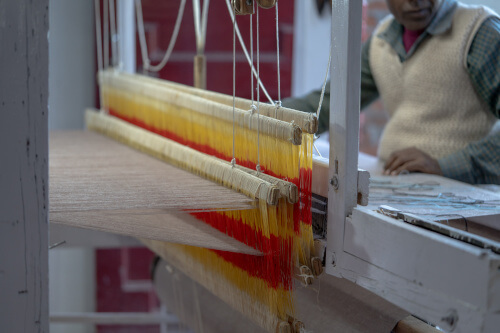Have you been working to diversify your supply chain recently? Your company may be one of the many organizations pursuing a China plus one strategy and assessing manufacturers in alternative countries.
One country that’s been frequently in the spotlight is India—due to its economic growth, technological advancements, and large, youthful workforce. Over the last decade, India has invested heavily in its manufacturing sector.
Could India hold potential for your business? Here, we explore factors that could impact your decision, including product types, infrastructure, and labor force. Read on to better understand whether India might be a good option for you.
Table of Contents
What are India’s Top Exports?

Let’s look at India’s highest-value exports in 2023—here are the top 15.
- Processed petroleum oils US$85.3 billion (-9.6% change since 2022)
- Medication mixes in dosage $18.8 billion (+7.9%)
- Diamonds (unmounted/unset) $18.2 billion (-24.1%)
- Phone devices including smartphones $15.6 billion (+43.1%)
- Jewelry $12.7 billion (+3.2%)
- Rice $10.5 billion (-2.8%)
- Automobile parts/accessories $7.04 billion (+5.7%)
- Cars $6.7 billion (+2.1%)
- Aluminum (unwrought) $4.8 billion (-32.8%)
- Crustaceans (including lobsters) $4.4 billion (-9.5%)
- Packaged insecticides/fungicides/herbicides $4.3 billion (-22.1%)
- Turbo-jets $4.1 billion (+21.8%)
- Heterocyclics, nucleic acids $3.99 billion (-0.1%)
- Sugar (cane or beet) $3.7 billion (-35.2%)
- Iron ores, concentrates $3.6 billion (+129%)
Smartphones have been a major growth area for India. Apple and other large multinational companies increasingly assemble devices there. Per Bloomberg, “The US tech giant now makes as much as 14% or about 1 in 7 of its marquee devices from India.”
What About Your Product?

As a general rule, the newer and more complex your consumer product is and the smaller your company is, the more sense it makes to produce it in China. India tends to be a better fit for those with established products and processes and simpler products.
In working with our clients, we’ve seen companies shift a variety of mature consumer goods to India. These include bags—from high-end to low-end—such as messenger bags and backpacks. We’ve also worked with clients producing stainless steel goods like pet bowls and even commercial-grade products.
These days, there are opportunities to make a wider variety of products than in the past. It’s possible that the ‘Make in India’ initiative—which aims to build up the country’s manufacturing capabilities—is having a positive impact.
The Make in India Initiative

Narendra Modi
Source: Prime Minister’s Office, GODL-India, via Wikimedia Commons
In 2014, Prime Minister Narendra Modi introduced the much-discussed Make in India Initiative. It aims to:
- Attract foreign investment
- Enhance skill development
- Build world-class infrastructure
- Strengthen India’s manufacturing sector
India has made significant reforms to the manufacturing sector, including key policy changes and relaxed corporate taxes. This program has likely contributed to the country’s growth in foreign direct investment (FDI). Total annual FDI rose from $45.15 billion to $83 billion over the course of eight years.
One common complaint about manufacturing in India is a lack of good infrastructure, which contributes to delays in production and shipments. So, how is Make in India impacting the country’s infrastructure?
India’s Infrastructure: Has it Improved?

Delhi–Meerut Expressway
Source: Aziza Bharati, CC BY-SA 4.0, via Wikimedia Commons
The rapid growth of the Indian economy in the past decade has put a heavy strain on critical infrastructure, which was already inadequate from the outset. This includes electricity, roads, railways, ports, airports, irrigation, water supply, and sanitation systems.
One positive sign is that between 2008 and 2017, the Indian government spent around $1.1 trillion on infrastructure. They made investments in roads, highways, freight corridors, port modernization, and power generation. According to the country’s Press Information Bureau, for 2019-2025, the country has set a target of $1.4 trillion in additional spending. So, is the spending paying off?
The last decade of investments seems to have helped India’s logistics performance. The World Bank’s Logistics Performance Index (LPI) benchmarks countries using indicators such as customs, infrastructure, and timeliness.
In 2012, India ranked 46th in the LPI, and 11 years later in 2023, the country ranked 38th—so, it appears they have moved up the table somewhat. How does this compare to other countries in Asia? In 2023:
- China ranked 19th.
- Malaysia ranked 26th
- Thailand ranked 34th
- Vietnam ranked 43rd
- Indonesia ranked 61st
Despite massive improvements, India still has a long way to go to compete with China’s well-established logistics infrastructure. However, things appear to be headed in a positive direction. What about India’s labor force?
The Current State of India’s Labor Force

India has the world’s second-largest workforce at 594 million, lagging only behind China which boasts 779 million. One of the big advantages India has over China is its labor costs, which impact the cost of manufacturing labor-intensive goods.
In both countries, the minimum wage varies based on geographic location, while in India, it also varies by profession or skill level. Here are some numbers for consideration.
China:
- Highest monthly minimum wage = $377/2690 CNY (Shanghai)
- Lowest monthly minimum wage = $216/1540 CNY (Jilin)
(Source: China Briefing)
India:
- National monthly minimum wage = $63.97/5340 INR
(Source: India Briefing)
The average skill level of India’s labor force is lower than that of many of its competitors in Asia. In the WEF’s 2017 Human Capital Report, India ranked 103rd for the knowledge and skills of its labor force, while China ranked 34th out of 130 countries.
The Indian government has taken many steps to incentivize worker upskilling and increase labor participation (particularly for women). India’s workforce has a long way to go to compete with China’s skills in manufacturing, but with China’s aging population, India will likely soon have the largest workforce in the world.
Is Manufacturing in India a Viable Option for Your Business?

The answer depends on your product’s specifics, whether it is new or mature, and your volumes. Generally, India is a better move for companies with mature products that they already produce in another country, such as China.
The more high-tech the product, the more difficult it will be to move manufacturing. Apple—a huge company—is moving iPhone production to India but relies on China for most components—using India for final assembly.
Many people report that it is not as easy to do business and hit the ground running as it is in China, so hopefully this will improve over time. If you are developing a new product, you would likely want to do it in China. But when it comes to existing products, we have worked with companies that shifted the production of bags, garments, and steel products to India. So, if you are making a similar product, there may be some good opportunities for you.
If you’re thinking about moving production to this country, see our video about how to successfully shift production to India or Pakistan.
Managing Quality Control in India: Insight Quality Can Help

Our quality control services in India may interest you if you moving production there. We can inspect your products at the factory to ensure that goods meet your expectations for quality before they ship.
We can also help you assess a new manufacturer by conducting a factory audit to determine whether they are capable of meeting your needs and have a sufficient quality control system in place. To learn more about factory audits, download the following guide.
Free Guide
How to Prepare for a Factory Audit
A factory audit helps you assess a supplier's systems, capacity, workplace environment, or capabilities to ensure they meet your requirements as a buyer.
But which type of audit should you conduct, and which points should you cover on your checklist? In this free guide, you'll learn how to run an effective supplier assessment.





Very insightful. Thank you
Glad you found it helpful!
-Billy Miner